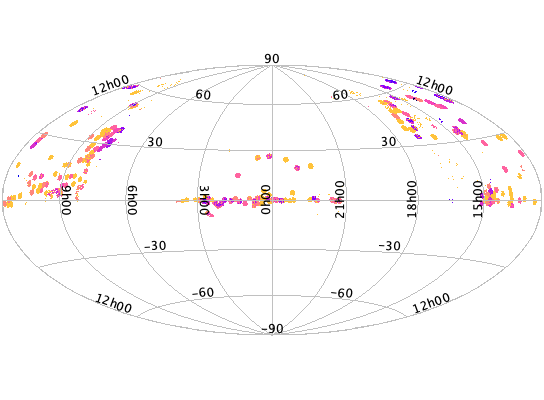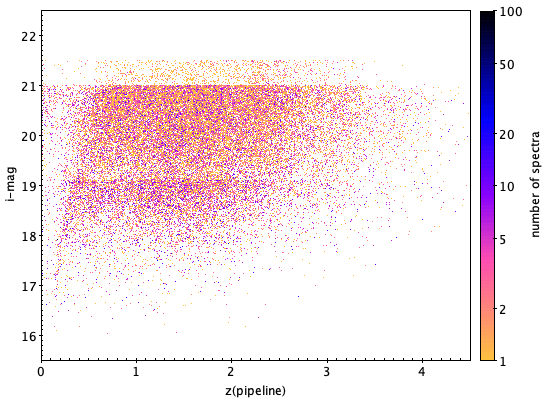All-Quasar Multi-Epoch Spectroscopy
Summary
The All-Quasar Multi-Epoch Spectroscopy (AQMES) program aims to temporally resolve a wide variety of astrophysical phenomena related to supermassive black hole (SMBH) accretion. This includes changes in the broad line region (BLR) on the dynamical time scale (of order months to years), variability in quasar outflows on similarly long time scales, accretion state or other abrupt transitions (such as changing look quasars), binary BH signatures, etc.
AQMES conducts repeat spectroscopy of a large sample of confirmed quasars that were previously observed by SDSS in order to capture and measure their UV/optical spectral features. It is sensitive to broad emission line variations of order 10% in flux density and resolves timescales from months to a decade. When combined also with observations from the BHM reverberation mapping (RM) program and observations from past SDSS programs (and other surveys), the time sampling allows one to explore the widest reasonably accessible range of temporal baselines, from a few days to two decades, i.e. from the light-crossing time of the inner BLR, to the dynamical time of the outer BLR, and including key accretion-related timescales.
The quasar sample targeted by the core components of AQMES (~20,000 quasars) and cadence distribution (1–10 new epochs added to those already in the SDSS archive) should enable significant advances over past time-domain spectroscopic studies. The resulting data set will allow statistical analysis, including averaging in sub-samples defined by basic parameters such as luminosity, black hole mass, Eddington ratio. Moreover, the SDSS-V sky coverage and spectral quality should allow comparison to extant large archival spectral datasets.

Observational goals and requirements
The SDSS-V/BHM AQMES core program seeks to gather high signal-to-noise ratio (S/N) repeat spectrophotometry of known, luminous broad-line quasars in order to quantify their variability properties. For a “core” sample of such quasars with 𝑖 < 19.1, spectra with S/N ≈ 10 might be typical in a 1-hour exposure while bright quasars with 𝑖 = 18 yield spectra with S/N ≈ 20 in a similar exposure time. These spectra are aimed to allow measurements of the centroids of the broad emission lines to 0.1% or better and radial velocity changes to 65 km/s or better. The basic shape properties of line profiles (widths and velocity dispersions) should be measurable to ~10%, while higher-order moments should be measurable to ~20%.
One of the primary goals of AQMES is to resolve time scales on the order of the dynamical time of the broad line region (BLR) for a range of black hole masses and luminosities — time scales which range from a few weeks to a century, given the expected range of accessible masses and luminosities. The AQMES observations combined with past SDSS archival observations of the same quasars will be able to probe time scales between 100 and 6000 days (a few months to decades), while the observations from the reverberation mapping (RM) program will cover even shorter time scales. The time resolution needed to achieve the above goal is 0.2 dex (5 logarithmically spaced bins per order of magnitude in time) or better, across the above range of time scales. These considerations apply to all the science questions that the core AQMES program aims to address, including the variability of emission and absorption lines, abrupt and dramatic spectroscopic changes, radial velocity variations, etc. Since the amplitude of quasar variability anti-correlates with luminosity and given the wide range of quasar redshifts and luminosities accessible through the AQMES observations, the actual survey planning takes into account the resulting distribution of targets in the luminosity vs. rest-frame time interval plane.
Meeting the science goal of sampling the luminosity–time interval plane, requires (a) a core sample of ~2,000 bright quasars observed on month-years timescales (i.e. ~10 times over the course of the 5-year survey), and (b) a sample of ~20,000 bright quasars sampled on years-decades timescales (~1-2 times over the course of the survey). The sizes of these samples are dictated by the need to reduce the uncertainties in variability distribution functions (a.k.a. “structure functions”), so that they are comparable to those of the individual spectroscopic measurements. Hence ~500 “time intervals” (i.e., pairs of spectroscopic observations from which differences can be measured) per structure function bin (of width 0.2 dex) are needed by the end of the survey.
The figure below shows how bins in the luminosity–time interval diagram will be populated, according to simulations of the AQMES observing cadence. Every row in this diagram (or slice along the time interval axis) represents the data needed for a structure function. When the AQMES results are combined with archival (DR16Q, Lyke et al. 2020) spectra, the desired range of time scales will be adequately sampled over a wide range of quasar luminosities. Such a sampling would not be possible with archival spectra alone. Moreover, since the bins in this 2-dimensional diagram are very well populated they can be subdivided into bins along a third dimension, such as black hole mass or Eddington ratio. Therefore, at the end of the survey structure functions can be constructed as a function of at least two fundamental system parameters.

Target selection and survey implementation
The AQMES program is implemented as a set of targets grouped into a number of target ‘cartons’. The medium-intensity cadence (~10 new epochs) program will observe targets in the ‘bhm_aqmes_med*’ cartons. The wider tier of AQMES (~1-2 new epochs) observe targets from the ‘bhm_aqmes_wide*’ cartons. For each AQMES tier there is a core sample of brighter quasars (16<psfmag_i<19.1 AB), supplemented by a sample of fainter quasars (19.1<psfmag_i<21.0 AB). The sky areas for these core AQMES programs are selected taking account several factors, including: sky density of bright quasars, availability of Chandra Source Catalog (CSC) targets, overlap with the SPIDERS footprint, and expected availability of observing time as a function of local sidereal time (LST).
We also opportunistically re-observe any previously known quasar from SDSS DR16Q (Lyke et al. 2020) regardless of sky location, if and when spare fiber resources are available. This non-core BHM program is implemented in, for example, via cartons labelled ‘bhm_aqmes_bonus*’, with separate cartons depending on the optical brightness of the quasars.
Further details of the algorithms and criteria used to select AQMES target cartons are provided via the links below.
Targeting generations used in early FPS operations
The ‘v0.5.epsilon-7-core-0’, ‘v0.5.2’, ‘v0.5.3’ and ‘v0.5.5’ targeting generations were used during initial SDSS-V/FPS operations (2022-2023). All of these generations are identical from the point of view of AQMES targeting. Below is a list of AQMES cartons that were considered (the carton names link to detailed descriptions):
- bhm_aqmes_med
- bhm_aqmes_wide2
- bhm_aqmes_med_faint
- bhm_aqmes_wide2_faint
- bhm_aqmes_bonus_bright
- bhm_aqmes_bonus_core
- bhm_aqmes_bonus_faint
Targeting generation used during SDSS-V plate operations
The ‘v0.plates’ targeting generation was used during the first year of SDSS-V operations at APO when the old plug plate system was still in place. We included early versions of the AQMES cartons during this phase, as listed below (the carton names link to detailed descriptions):
- bhm_aqmes_med
- bhm_aqmes_wide2
- bhm_aqmes_wide3
- bhm_aqmes_med-faint
- bhm_aqmes_wide2-faint
- bhm_aqmes_wide3-faint
- bhm_aqmes_bonus-bright
- bhm_aqmes_bonus-dark
Spectroscopic data released in DR19
DR19 includes the release of a total of ~135,000 BOSS spectra for ~45,000 distinct quasars most closely related to the AQMES program. In each case these AQMES targets already had at least one earlier epoch of optical spectroscopy from previous generations of SDSS, and e.g., were included in the DR16 quasar catalog of Lyke et al. (2020) About one-fourth of these AQMES targets and spectra in DR19 are specifically associated with the AQMES core targets described above (brighter than i<19.1), e.g., with ~35,000 recent spectra for nearly ~10,000 such distinct core quasars added in DR19 alone.


The number of AQMES spectra in DR19 are given in the tables below. Note that hyphens were used in early plate-era carton naming, but these have been replaced with underscores (for consistency with the later FPS era carton naming scheme).
| (First)Carton name | “daily” coadd spectra | “epoch” coadd spectra | Unique targets |
|---|---|---|---|
| bhm_aqmes_med_faint | 39845 | 25698 | 7818 |
| bhm_aqmes_wide2_faint | 27182 | 21585 | 11689 |
| bhm_aqmes_med | 15798 | 10192 | 2389 |
| bhm_aqmes_bonus_faint | 13659 | 10846 | 7674 |
| bhm_aqmes_wide2 | 13324 | 10250 | 5784 |
| bhm_aqmes_wide3_faint | 12002 | 8998 | 4094 |
| bhm_aqmes_bonus_dark | 5783 | 4444 | 3910 |
| bhm_aqmes_wide3 | 5664 | 4160 | 1681 |
| bhm_aqmes_bonus_core | 741 | 639 | 348 |
| bhm_aqmes_bonus_bright | 590 | 233 | 124 |
Back to Black Hole Mapper Science Programs
